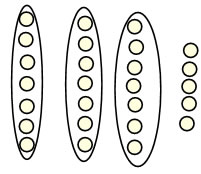
* 1. Draw and label array diagrams to show that the number of objects in each group if you split 12 into 4 groups is the same as the number of groups you get if you split 12 into groups of 4.
2. Write the missing number multiplication problem that corresponds to 20 ÷ 4
3. Write the fact family for the fact: 18 ÷ 3= 6
4. What numbers is it easiest to divide by when trying to mentally make a known number equal groups (partitive thinking)?
5. What is the most natural counting strategy when trying to mentally divide into equal groups of a known size (measurement division)?
6. What is the most efficient strategy for basic fact division (dividing within 100)?
7. In the problem 26 ÷ 7 what is the dividend? What is the divisor? What is the quotient? What is the remainder?
* 8. Write the number sentence shows how the dividend, divisor, quotient and remainder in the following division problem are related using multiplication and addition:
26 ÷ 8 = 3 R 2
* 9. Interpret 26 ÷ 8 = as a partition division problem. What does it mean? (26 divided into .....?) Sketch what it would look like if you make a partition division diagram for the problem.
* 10. Interpret 26 ÷ 8 = as a measurement division problem. What does it mean? (26 divided into .....?) Sketch what it would look like if you make a measurement division diagram for the problem.
11. Could this be a diagram for 26 ÷ 3? Why or why not? If not, what division problem could it be a diagram for (if any)?
12. For each word problem, tell your answer, and tell whether the answer is the quotient, the remainder or something else (explain what else it is).
A. 20 pencils are shared between 6 children. How many pencils should each child get?
B. 6 eggs can fit in a small egg carton. I need to put 20 eggs in egg cartons. How many egg cartons do I need?
C. Ms. Jensen has 40 pencils. She wants to put the same number of pencils at each of 6 tables, and she will put any extra pencils away in her drawer. How many pencils will she put in her drawer?
* 13. Write a division word problem for 14 ÷ 4 where the answer is
A. The quotient
B. The remainder
C. One more than the quotient
*These are problems that I can't put in a D2L quiz very well, but are then even more likely to turn up on a test.